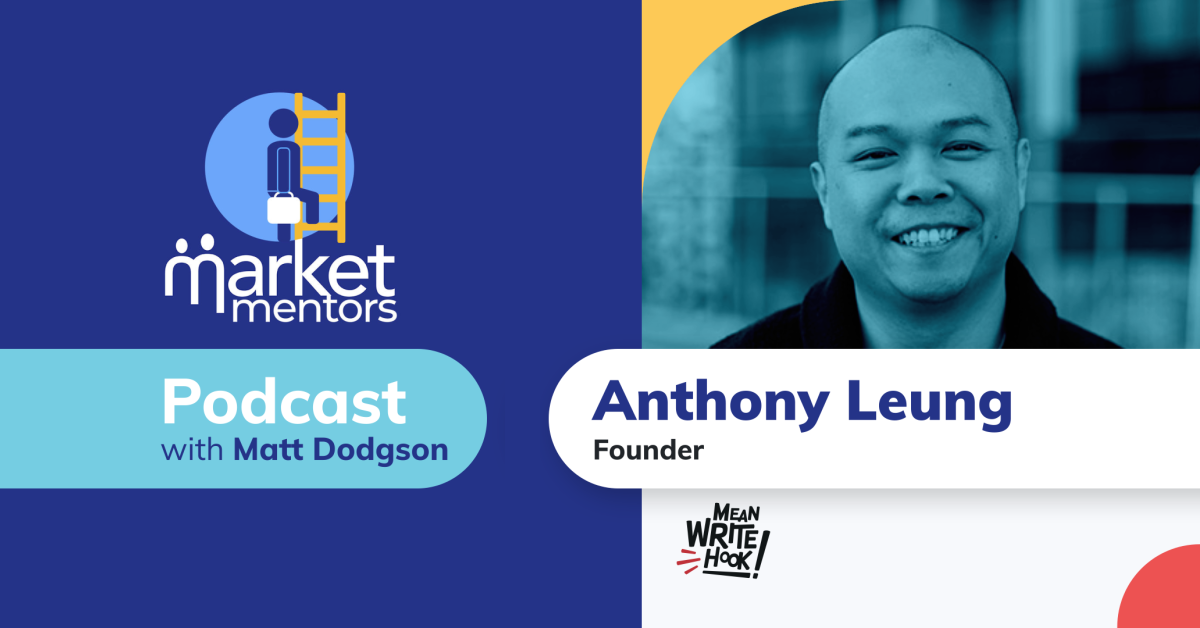
In today’s fast-paced world, attention spans are shrinking, and the demand for quick and easily consumable content is on the rise. As a result, many companies are turning their long-form content into short-form content to cater to these changing preferences.
And in this podcast, I talk to Anthony Leung, the Founder of Mean Write Hook, and explore why companies should consider repurposing long-form content, the benefits of short-form content, and some practical tips on how to create engaging short-form pieces in the first place.
Who they are: Anthony Leung is the Founder at Mean Write Hook
A bit of background: Ant has been in the content marketing and social media space for close to twenty years, having worked for B2C companies like Pret a Manger, Just Eat, and Simba Sleep, as well as B2B brands like Rackspace and Rentokil Initial. Right now, he runs Mean Write Hook, an agency helping companies turn their blogs, webinars, podcasts, and keynote videos into impactful social content.
Where you can find Ant:
Connect with Ant in LinkedIn here
Long-form content, such as whitepapers, e-guides, or podcasts, undoubtedly has its place. However, with the rise of social media and mobile browsing, people are more likely to engage with shorter, snackable content. By repurposing long-form pieces into shorter formats, B2B tech companies can engage their target audiences and help create demand.
One of the main reasons why companies should consider turning long-form content into short-form content is the shift in people’s behaviour. As people increasingly rely on their smartphones and tablets for information consumption, they have developed shorter attention spans. Combine this with the fact that B2B technology categories are far more competitive than they ever used to be, and it’s easy to see why companies are making this shift.
Ant goes on to explain:
‘A lot of B2B businesses measure their success through leads like how many downloads we receive or how many people register for a webinar. And I think that is still a necessary thing. But that also goes against the strength of these social media platforms, which is to tell short stories and be persuasive over time.’
‘And if our goal is always to just try to get them to download the long-form guide just so that we can capture data, then we’ve missed the opportunity to actually persuade them and put our brand on top of mind.’
🎧 Further listening: Using Entertaining Content in B2B to Cut Through the Noise
When repurposing long-form content, it’s crucial to understand your audience. Here are some tips to ensure a successful transition:
Ant explains:
‘I would say don’t stress over the format so much. Stress about what your narrative is and how you can tell it in short little stories. And then think about what assets you have, right? If you are not comfortable with cameras, don’t force yourself to go onto the camera first. Try carousels, try using images, but really try to land a narrative in short form content before you start going, I think that this is going to be better on video.’
‘With that said, I think that our faces are one of the last currencies on social media right now. With the advancement of AI, there’s so many people that can just pump out content left, right, and centre. Not all of it is great, but oh my goodness, there’s so much of it. Whereas if you’re on camera and you’re delivering it, that’s a quick way to establish some sort of trust that this isn’t just generated from AI. This is actually at least delivered by a human being. I think that if you are putting our faces on there, whether it’s on video or if it’s on a post or on a carousel, even putting a human face on it, I think that makes a massive difference.’
Short-form content presents an excellent opportunity to increase your reach by leveraging social media platforms and other online channels. Consider the following strategies to maximise your content’s exposure:
Each platform has its own unique characteristics and audience preferences. To maximise engagement and ensure your content resonates with each platform, adapt your short-form content accordingly. For instance, on Twitter, focus on crafting concise and attention-grabbing messages with relevant hashtags, while on Instagram, highlight visually appealing elements accompanied by captivating captions.
However, remember that every new platform you choose requires even more time and budget to create. And for the majority of B2B tech marketers, those are two things they don’t always have plenty of.
Ant explains:
‘I think that LinkedIn right now is a key channel for B2B businesses. One being that it’s on the rise; the more people are using it, the more your audience is there. So you’re not fighting against the Charli D’Amelio’s of the world, where they pop up and dance.’
‘And the second thing I would think of is that TikTok is great, Instagram is great, and all this other stuff is great. But every time you show up on a different channel, more energy is needed to create content for that channel. Because those channels are so format specific. That means that you need to do a bunch of videos. That means you need to shoot a bunch of photos. And how I see it is, if you can show up on one channel and be great on that channel, then the rest can follow.’
Subscribe to our fortnightly newsletter to hear about our latest podcasts, blogs, career advice & jobs.